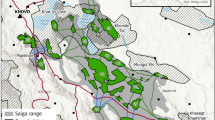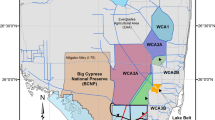Abstract
Isolated habitats can be compared and ranked by comparing their interior-to-edge ratio (I/E). We would like to show here that results based on ranking by I/E ratio sometimes contradict Diamond's rule, which ranks the most rounded habitat (i.e. most compact) as the best one. The reason for this contradiction is the frequently overlooked size dependence of the I/E. Being the interior-to-edge ratio size dependent, from a given set of habitats of different sizes, compact shaped (rounded) habitats might have worse I/E ratios than elongated or irregular ones.
Similar content being viewed by others
REFERENCES
Bogaert, J., P. Van Hecke, D. Salvador-Van Eysenrode and I. Impens (1998). Quantifying habitat edge for nature reserve design. Coenoses 13: 131-136.
Bogaert, J., P. Van Hecke and I. Impens (1999a). A reference value for the interior-to-edge ratio of isolated habitats. Acta Biotheoretica 47: 67-77.
Bogaert, J., P. Van Hecke, R. Moermans and I. Impens (1999b). Twist number statistics as an additional measure of habitat perimeter irregularity. Environmental and Ecological Statistics 6: 275-290.
Bogaert, J., R. Rousseau, P. Van Hecke and I. Impens (2000). Alternative area-perimeter ratios for measurement of 2d shape compactness of habitats. Applied Mathematics and Computation 111: 71-85.
Burrough, P.A. (1981). Fractal dimensions of landscapes and other environmental data. Nature 294: 240-242.
Diamond, J.M. (1975). The island dilemma: lessons of modern biogeographic studies for the design of natural reserves. Biological Conservation 7: 129-146.
Forman, R.T.T. (1997). Land mosaics — The ecology of landscapes and regions, Cambridge University Press.
Game, M. (1980). Best shape for nature reserves. Nature 287: 630-632.
Gehlhausen, S.M., M.W. Schwartz, and C.K. Augspurger (2000). Vegetation and microclimatic edge effects in two mixed mesophytic forest fragments. Plant Ecology 147: 21-35.
Hansen, A.J. and F. di Castri (editors) (1992). Landscape boundaries — consequences for biotic diversity and ecological flows. Springer-Verlag, Berlin/Heidelberg.
Mandelbrot, B.B. (1982). The Fractal Geometry of Nature. Freeman, San Francisco.
Peterson, G.W. and R.E. Turner (1994). The Value of Salt Marsh Edge vs. Interior as a Habitat for Fish and Decapod Crustaceans in a Louisiana Tidal Marsh. Estuaries 17: 235-262.
Patton, D.R. (1975). A diversity index for quantifying habitat „edge”. Wildlife Society Bulletin 3: 171-173.
Saunders, D.A., R.J. Hobbs and C.R. Margules (1991). Biological consequences of ecosystem fragmentation: a review. Conservation Biology 5: 18-32.
Author information
Authors and Affiliations
Rights and permissions
About this article
Cite this article
Imre, A. About the Ranking of Isolated Habitats with Different Shapes: An Interior-to-Edge Ratio Study. Acta Biotheor 49, 115–120 (2001). https://doi.org/10.1023/A:1010235911901
Issue Date:
DOI: https://doi.org/10.1023/A:1010235911901




